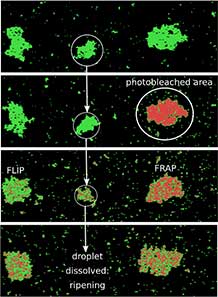Liquid-Liquid Phase Separation
Cover design by Dr. Laura Alvarez-Frances
We use statistical physics methods to predict how the collective behaviour of (biological) macromolecules gives rise to the emergence of large ordered structures. This relation between the microscopic and macroscopic world is graphically captured in the cover design (shown right top) of the journal Soft Matter in 2019, where we discuss circumstances under which the individual behaviour of molecules cannot be replaced by their average (mean-field) behaviour.
We are particularly interested how this collective behaviour results in Liquid-Liquid Phase Separation (LLPS) phenomena. LLPS is a transition where a homogeneous liquid spontaneously demixes into two coexisting liquids, like water and oil. Traditionally, LLPS is used to adjust the toughness of metal alloys, like bronze, and polymer composites for mechanical (eg, high-impact polystyrene) or electronic (eg, organic photovoltaics, https://10.1021/acs.macromol.6b00537)) applications.

More recently, LLPS is widely recognised to be of vital importance to enable living cells to create dynamic, membraneless organelles. Their functionalities range from controlling molecular conversions to the temporary storage of vital proteins and RNA as a strategy to survive heat shocks and antibiotic attacks.
The Physics of Life group researches LLPS phenomena through experiments where the fluorescence loss (FLIP) and recovery (FRAP) of fluorescently-labelled proteins is measured following “photo-bleaching”. We support the interpretation of such experiments theoretically using ‘Individual-Based Model’ simulations. The image on the right shows how our simulations describe the emergence of membrane-less organelles in living cells, how they dissolve again, and how the bleached (red) andnon-bleached (green) proteins redistribute themselves through diffusion, which is responsible for the experimentally observed FLIP and FRAP signals.
Schaefer, Charley, Stefan Paquay and Tom C. B. McLeish, ‘Morphology formation in binary mixtures upon gradual destabilisation’, Soft Matter, online DOI: 10.1039/c9sm01344j (2019)P. Schuetz, M.J. Greenhall, J. Bent, S. Furzeland, D. Atkins, M.F. Butler, T.C.B. McLeish and D.M.A. Buzza, “Controlling the Self-Assembly of Binary Copolymer Mixtures in Solution through Molecular Architecture” Macromolecules, 44, 5510-5519 (2011).

-218.jpg)